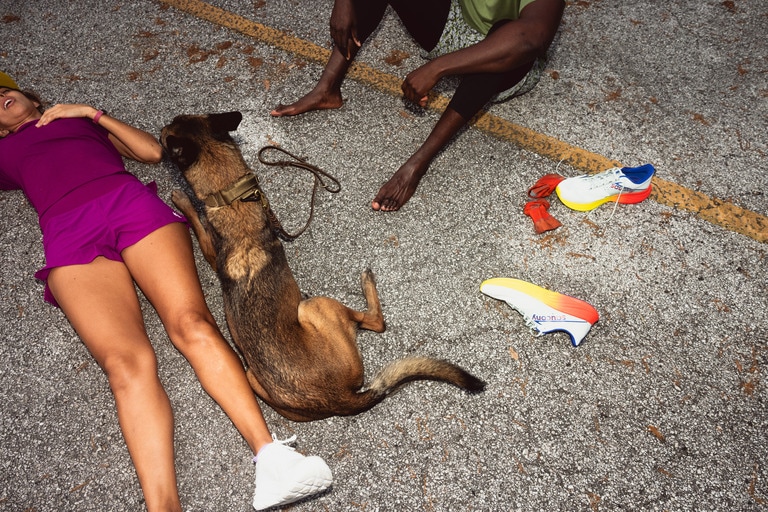Before beginning any training plan, check in with your doctor or certified training professional to talk about what is right for you.
For many, the journey back to running after a significant break can be fraught with uncertainties, a landscape marked by physical challenges and mental obstacles. After just three weeks away from running, your body will start to lose fitness; several months or years away can make you feel like a beginner once more. What once may have been a pleasurable or meditative activity may now feel frustrating—each step heavier, burdened by the weight of big expectations, and haunted by the specter of past achievements. But some changes in approach and mindset can spin the negatives into hard-won positives.
Whether you’re returning from injury or burnout, are postpartum, or simply let your routine slip, there’s hope. We asked experts how to navigate the challenges of returning to running, including Coach Mireille Sine, a trailblazer in the realm of beginner and intermediate running; Dr. Anh Bui, a physical therapist specializing in running injuries; and Peter Bromka, a seasoned runner, writer and coach.
Read on for the full article or click on the links below:
Getting Started, Again: How to approach those first several runs back
Recovery: Navigating a return to running after injury
Postpartum: General guidance for runners who have recently given birth
Longevity: Tips on building a running routine you’ll want to stick with
Getting Started Again with Running
"First, when you’re new to running or just restarting, it’s important to let your current fitness level dictate your goals and not the other way around," Sine says, encouraging runners to approach their journey with humility and self-awareness. The following tips will help you do just that, prioritizing how you feel on the run rather than competing with past metrics.
Try a run/walk approach. A run/walk approach involves intervals of running and walking—for example, 1 minute running followed by 1 minute walking or 5 minutes walking followed by 1 minute running. The ratio will depend on your fitness level, and it’s important to listen to your body as a guide for what these intervals should be. But in general, you’ll want to keep your heart rate in your zone 1 or 2, maintaining an easy, conversational pace.
Read more: How to Train Using Heart Rate Zones
Run by time, not miles. By focusing on running by time rather than mileage, you can embrace the journey back to running at your own pace, allowing for flexibility and adaptation along the way. "Include at least one rest day in your weekly schedule when starting out," Sine advises, underscoring the importance of recovery and self-care in the pursuit of long-term success. And for the days when you’re not running, you can build your base by cross-training, which might include lifting, cycling, swimming, or cross-country skiing. ”The purpose of cross-training is to build strength while reducing the impact that running can have on your body,” she says.
Find running buddies. For runners seeking community and camaraderie, Sine suggests participating in running clubs and social events. Running with others can also help pass the time more quickly, and lower your rate of perceived exertion.
Prioritize fueling and hydration. As runners embark on their journey back to the activity, it’s crucial that they fuel their bodies for optimal performance and recovery, says Sine. "A fueled athlete is a strong athlete." A balanced approach to nutrition and hydration will support the demands of a new, more active routine.
Read more: Runners’ Nutrition Basics
Ultimately, a return to running should be a return to yourself. “Let go of what you think running is supposed to look like and embrace what it looks like for you,” says Sine.
Navigating the Path to Recovery
Returning to running after injury or illness can be a daunting task, and fear of re-injury can make it hard to stay consistent. But with the right approach, the process can be manageable and rewarding. Bui, who has a doctorate in physical therapy, emphasizes the importance of a proper pre-run routine, gradual mileage increase, and post-run recovery to avoid overuse injuries. She explains, “For the most part, running injuries can be avoidable by following general return-to-run guidelines.” Her expert advice provides a comprehensive path to rebuilding fitness safely and effectively.

If you’ve been injured, consult a physical therapist or other medical professional. “At some point in every runner's career, they're going to have to deal with time off due to injury,” says Bui, owner of Run Resiliently Physical Therapy in Oakland, California. A professional can help identify the root causes of your injury and come up with a plan to treat the issue. At her practice, she will first evaluate a runner’s strength, balance, and mobility. These tests involve exercises like leg hops (60 times on each leg), single-leg squats and single-leg glute bridges (20 of each per side), planks (30 seconds on the front and sides), split squat lunges (1-minute duration), and single-leg calf raises (25-30 per side). For those who see a cycle of the same injuries, Bui recommends seeking professional help from a physical therapist who has expertise in running.
Have a pre-run warm-up routine. For Bui, a proper routine can make all the difference in preparing an athlete for the demands of running. This should include pre-run dynamic stretching (e.g. leg swings, knee hugs, hip circles) to improve the range of motion and increase blood flow to the muscles. Incorporating running drills 1-2x/week can also improve running mechanics and efficiency.
Read more: Stretches for Running
Cool down post-run. After your runs, if you have time, you can foam roll the major muscle groups for running (quads, hamstrings, adductors, glutes, etc). At the end of the day, the most important thing is you have a routine that works for you. “Don't stress about it being perfect,” Bui says.
Don’t do too much too soon. The overuse injuries Bui often sees in runners tend to come from doing too much too soon. “I like to remind my patients that running places a lot of stressful impact on the body, and the muscles, tendons, and bones need time to adapt to that impact.” Bui says you should spend as many weeks or months building up your base mileage as the time you took off from running. And it’s important to build your mileage very gradually after injury or any prolonged break. One helpful guide is the 10% rule, where you add no more than 10% additional mileage from week to week while also taking a down week, where you bring your mileage back down to baseline, every four weeks. “As you build baseline fitness, your running form also naturally becomes a little more efficient in absorbing the impact over time,” she says.
Rediscovering Running Postpartum
Postpartum experiences vary from person to person, and runners should consult their physician before returning to activity after giving birth.
Being a postpartum runner involves unique challenges, requiring a careful balance of physical recovery and the demands of new parenthood. Bui, who often works with postpartum runners, offers practical guidance on how to manage this transition safely and effectively.
Be flexible with your running expectations. Balancing a running routine with the demands of caring for a newborn can be challenging. Bui emphasizes the importance of flexibility and listening to your body. "If you didn't sleep well, take that day off from running.” Being a new parent is a major shift in lifestyle, so paying attention to what your body is saying is essential. Start with an unstructured walk-run routine, and if energy levels improve with exercise, postpartum athletes can progress their running duration, she says.
Gradually reintroduce speed work or higher-intensity sessions. Postpartum runners can consider reintroducing higher-intensity running or speedwork if they have successfully returned to their baseline mileage running at an easy pace for 4-8 weeks without experiencing aches, pains or urinary incontinence. Bui highly recommends checking in with a pelvic floor physical therapist to incorporate rehab exercises, especially if you had a cesarean section, to accelerate the recovery process.
Rebuild core stability and pelvic floor strength. Bui recommends starting gentle core stability exercises one to two days postpartum. One example is transverse abdominis activation which can be done first from a seated position, before transitioning to standing:
Lying on your back with knees bent, place your fingers about 2 inches away from your belly button and slightly below.
Draw your belly button towards the floor.
You will feel the core muscles contract underneath your fingers. Make sure you are not holding your breath!
Postpartum runners should also be aware of certain signs that indicate the need to adjust training intensity or seek professional help, including urinary incontinence, sensations of pelvic floor heaviness or any musculoskeletal pain (back, sacroiliac joint, hip, knee) during running.
Related Reading: How to Run While Pregnant
Running for the Long Haul
Don’t compare. Bromka, who coaches a wide range of athletes from beginners to Olympic Marathon Trials participants, urges runners to start their journey from a place of acceptance and humility and avoid comparing themselves to others or even past versions of themselves. “Whether having missed a day, a week or years, the key is having the humble willingness to accept where your body is and offer the effort that is available on that day.” This also means resisting the desire to “make up” missed runs or workouts. ”Your body doesn’t know what the schedule was, and it doesn’t deserve to take on too much too soon because of previous life conflicts,” Bromka says.
Add some speedwork, but keep it simple. To reclaim one’s stride, Bromka encourages runners to engage in simple, yet effective, up-tempo efforts, like strides or walk-run intervals. “Whether going from a jog to a sprint or from a walk to a jog, the goal is to move through basic effort levels without ever looking at your watch for feedback.”

Embrace the hills (and trails). For those seeking a more structured return to running, Bromka suggests finding a new hill and repeatedly running up it at a controlled effort. This deliberate focus on form and intensity not only strengthens our bodies but also helps us avoid the dangerous comparison trap of past performance. Running hills (whether on the road or trail) is more about the effort and experience than it is about the time on the clock. By embracing the nuances of effort and sensation, we cultivate a deeper connection with our bodies and the joy of movement itself.
“The whole goal is to shift through movements without glancing at your watch, to remember how breathing feels, your legs burn, and your face begins to flush at different effort levels,” Bromka says. This more feel-based approach, championed by each expert, can help runners connect to the sport again and actually stick with it long enough to see improvements.
The return to running “can feel awful,” Bromka admits. But a lot can be gained from savoring the journey. “With appropriate perspective and appreciation for the simple joy of movement, fitness and strength will return, along with renewed appreciation for your love of this beautiful sport.”




